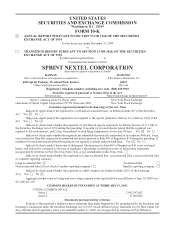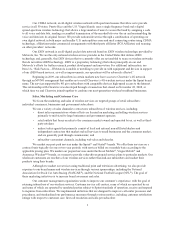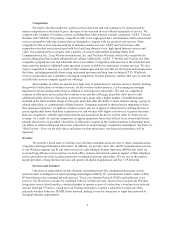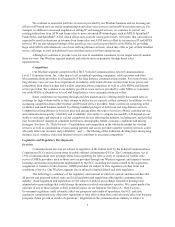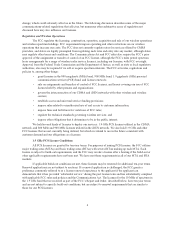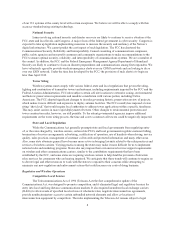Sprint - Nextel 2008 Annual Report Download - page 7
Download and view the complete annual report
Please find page 7 of the 2008 Sprint - Nextel annual report below. You can navigate through the pages in the report by either clicking on the pages listed below, or by using the keyword search tool below to find specific information within the annual report.We continue to assess the portfolio of services provided by our Wireline business and are focusing our
efforts on IP-based services and de-emphasizing stand-alone voice services and non-IP-based data services. For
example, in addition to increased emphasis on selling IP and managed services, we continue to convert our
existing subscribers from ATM and frame relay to more advanced IP technologies, such as MPLS, Sprintlink®
Frame Relay and Sprintlink®ATM, which allows us to provide converged services. Over time, this conversion is
expected to result in decreases in revenue from frame relay and ATM service offset by increases in IP and MPLS
services. We are also taking advantage of the growth in voice services provided by cable MSOs, by providing
large cable MSOs with wholesale voice local and long distance services, which they offer as part of their bundled
service offerings, as well as traditional voice and data services for their enterprise use.
Although we continue to provide voice services to residential consumers, we no longer actively market
those services. Our Wireline segment markets and sells its services primarily through direct sales
representatives.
Competition
Our Wireline segment competes with AT&T, Verizon Communications, Qwest Communications,
Level 3 Communications, Inc., other major local incumbent operating companies, cable operators and other
telecommunications providers in all segments of the long distance communications market. For several years, our
long distance voice services have experienced an industry-wide trend of lower revenue from lower prices and
competition from other wireline and wireless communications companies, as well as cable MSOs and Internet
service providers. We continue to see industry growth in voice services provided by cable MSOs as consumers
use cable MSOs as alternatives to local and long distance voice communications providers.
Some competitors are targeting the high-end data market and are offering deeply discounted rates in
exchange for high-volume traffic as they attempt to utilize excess capacity in their networks. In addition, we face
increasing competition from other wireless and IP-based service providers. Many carriers are competing in the
residential and small business markets by offering bundled packages of both local and long distance services.
Competition in long distance is based on price and pricing plans, the types of services offered, customer service,
and communications quality, reliability and availability. Our ability to compete successfully will depend on our
ability to anticipate and respond to various competitive factors affecting the industry, including new services that
may be introduced, changes in consumer preferences, demographic trends, economic conditions and pricing
strategies. See Item 1A, “Risk Factors—Consolidation and competition in the wholesale market for wireline
services, as well as consolidation of our roaming partners and access providers used for wireless services, could
adversely affect our revenues and profitability” and “—The blurring of the traditional dividing lines among long
distance, local, wireless, video and Internet services contribute to increased competition.”
Legislative and Regulatory Developments
Overview
Communications services are subject to regulation at the federal level by the Federal Communications
Commission (FCC) and in certain states by public utilities commissions (PUCs). The Communications Act of
1934 (Communications Act) preempts states from regulating the rates or entry of commercial mobile radio
service (CMRS) providers, such as those services provided through our Wireless segment, and imposes various
licensing and technical requirements implemented by the FCC, including provisions related to the acquisition,
assignment or transfer of radio licenses. CMRS providers are subject to state regulation of other terms and
conditions of service. Our Wireline segment also is subject to limited federal and state regulation.
The following is a summary of the regulatory environment in which we operate and does not describe
all present and proposed federal, state and local legislation and regulations affecting the communications
industry. Some legislation and regulations are the subject of judicial proceedings, legislative hearings and
administrative proceedings that could change the manner in which our industry operates. We cannot predict the
outcome of any of these matters or their potential impact on our business. See Item 1A, “Risk Factors—
Government regulation could adversely affect our prospects and results of operations; the FCC and state
regulatory commissions may adopt new regulations or take other actions that could adversely affect our business
prospects, future growth or results of operations.” Regulation in the communications industry is subject to
5

